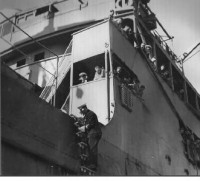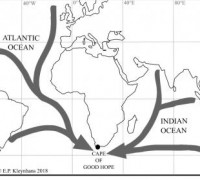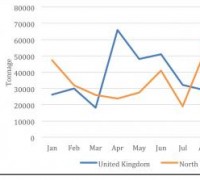THE AXIS AND ALLIED MARITIME OPERATIONS AROUND SOUTHERN AFRICA 1939 1945 - WAR ON SOUTHERN AFRICA SEA
13)THE NAVAL WARFARE THEORY
1.1 Naval warfare theory and the constructs of maritime strategy
A maritime strategy revolves around the principles which govern the conduct of war at sea.[1] The primary aim of any maritime strategy is to realise and preserve command at sea, where the ability to make full use of the sea waters and deny the enemy access, is of utmost importance. A secondary aim of maritime strategy is to create zones of maritime control across the globe during times of war. A maritime zone of control allows for the safe passage of commercial and military shipping. Such zones further restrict the enemy from using this same area for its sea communications. Complete dominion over such zones is, however, rarely established. In fact, control instead remains disputed as sporadic attacks and incursions form a constant threat. The uses of command at sea are varied but are primarily either offensive or defensive in nature. The naval theorist Alfred Mahan suggests six principles that influence the maritime strategy of a seapower. These are geographical position, physical conformation, the extent of territory, the population size, the national character, and the character of the government.[2]
Stephen Roskill, the erstwhile historian of the Royal Navy (RN), and author of the official histories on Britain’s naval contribution to the Second World War, further suggests that maritime power rests on the possession of three essential elements. These facets – strength, security and transport – must be ever-present for the successful fulfilment of a nation’s maritime strategy. The strength element comprises all the different instruments of war which work on or beneath the surface of the sea or in the air. Maritime control greatly depends on the tenacity and availability of such naval and air forces. The security factor relates to the possession and safety of the bases from which all the instruments of maritime power must work. If bases are lacking or inadequately defended, the ships and aircraft cannot fulfil their functions. The transport element predominantly pertains to the Merchant Navy. An adequate Merchant Navy is able to feed the home population, carry exports from overseas, and transport armies to various theatres. The support of the Merchant Navy is crucial, especially regarding a competent shipbuilding and ship-repair industry which enables the replacement of losses and repair of damaged ships.[3]
Historically there are six principal methods identified for the use of naval forces in war. First, the defence of coasts and harbours has been the concern of armies and air forces. Local naval forces, such as small craft, submarines and minefields, can act in a mutually supportive role to defend coasts and harbours. Second, maritime power projection entails all offensive operations from across the sea. This projection can include aerial and offshore bombardments, amphibious raids ashore, and fully-fledged invasions. Strong navies normally conduct such operations against weaker navies, often along sparsely defended coasts. Third, the fleet-in-being principally requires a substantial naval presence in a strategically located area to inhibit the successful deployment of a more powerful naval power.
The fourth method concerns the fleet battle, where the aim is to gain command of the sea. It thus involves the defeat or destruction of the enemy’s principal naval force at sea. After a successful fleet battle, friendly naval forces can redeploy to new operational areas to help destroy the enemy’s weaker warships or to capture, blockade and destroy other military and commercial shipping. Fifth, stronger fleets often employ military blockades to confine weaker fleets to port. Blockades succeed in achieving what successful fleet battles fail to do.
The last point is of significant importance to this study. It typically involves the weaker sea power taking recourse to commerce raiding in wartime.]4 Also known as a guerre de course, maritime commerce warfare has the explicit objective of frustrating the enemy by destroying or capturing its commercial shipping during the war. Commerce raiding is, however, decidedly opportunistic, and is considered the indecisive strategy of the weak in contemporary naval theory. Against this theoretical backdrop, blockade and interdiction regularly underpin maritime coercion. This is the case where larger states have more powerful naval forces to employ during periods of war. Accordingly, weaker nations accept their naval inferiority, with the caveat, however, that their navies are still strong enough to provide certain offensive options during the war period. Commerce raiding winds up being their natural response to blockade and interdiction, though it has no history of success – but only of distraction and damage.[5]
[1] Corbett, Some Principles of Maritime Strategy, p. 11. Also see Kennedy, Britain’s War at Sea, 19141918; Kennedy, The Royal Navy and Imperial Defence, 1919-1945; Lambert, War at Sea in the Age of Sail; Lambert, A Naval History of Great Britain; Lambert, Naval History 1850-Present; Potter and
Nimitz, Sea Power, A Naval Power; Till, Seapower: A Guide for the Twenty-First Century.
[2] Brodie, ‘New Tactics in Naval Warfare’, pp. 210-211; Herwig, ‘The Failure of German Sea Power, 1914-1945’, p. 70. Also see King, ‘The Role of Sea Power in International Security’, pp. 79-80; Stemmet, ‘Mahan se Teorie van Seemag’, pp. 35-37.
[3] Steury, ‘Naval Intelligence, the Atlantic Campaign and the Sinking of the Bismarck’, pp. 209-210; Roskill, The War at Sea: Volume I – The Defensive, pp. 6-7.
[4] Uhlig, ‘Fighting At and From the Sea: A Second Opinion’, pp. 39-45; Hughes, ‘Naval Operations: A Close Look at the Operational Level of War at Sea’, pp. 23-26.
[5] Peifer, ‘Maritime Commerce Warfare: The coercive response of the weak?’, pp. 83-85; McMahon, ‘Maritime Trade Warfare: A Strategy for the Twenty-First Century?’, pp. 15-38.



